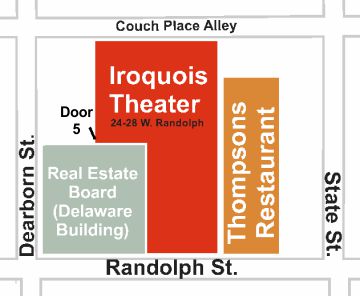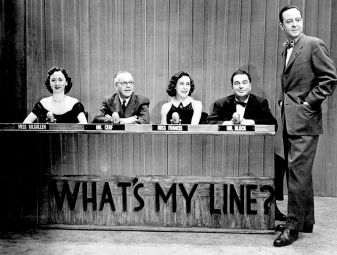|
In March 1957 a story about the Iroquois Theater fire appeared in a half dozen major
daily newspapers. It was written by a celebrated
International News Service journalist, James Kilgallen
(1888–1982),▼1 based upon
Kilgallen's interview with a retired
choreographer, Jack Haskell (1885–1963). In an account of
his experiences at the Iroquois Theater fire, Haskell made
various claims that conflict with other reports from
1903/4, reports corroborated by multiple witnesses. Those
discrepancies are discussed below. Chief amongst them is
that he was performing as a member of the
Pale Moonlight double octet
and on stage when
the fire broke out and that he rescued
comedian
Eddie Foy's son, Bryan.
No one questioned the truth of his
story publically in 1957, perhaps
because by then a majority of the
people who knew better were
deceased.
In 1957, at age seventy-two, Haskell's
choreography days were behind him, and he was "doing some
writing" (of which I found no evidence, so he may have used an
alias). Was he paid for the interview with Kilgallen?
Did he hope the story would somehow lead to writing assignments?
Eddie Foy and many of the octet members were deceased by 1957 but not all.
Haskell must have suspected there were people alive who would
recognize his lies, so his decision to fib is
curious. His possession of a
summons to testify at the coroner's inquest indicates Haskell
may have been a Mr. Bluebeard cast member, but nothing was
reported linking his name to the disaster until the 1957
interview. It appears that either Kilgallen was guilty of
putting words in Haskell's mouth,
which I doubt, or Kilgallen was taken for a
ride. Perhaps he trusted the old gent with his
treasured clippings. Haskell's
"documents" consisted of a photo of
the double octet and the order to
testify in the coroner's inquest,
both of which could have been
possessed by hundreds of stage hands
and performers, neither of which
substantiated that he was on stage
when the fire broke out or was Foy's
dresser. The fact that Haskell
carried the two documents to an
interview over fifty years after the
fire may indicate that his story had
been disputed previously.
|
|
|
Not
performing during fire
I found zero evidence of
Haskell's claim to have been a member of the octet,
at the Iroquois, or in Chicago, or even in the
theater industry prior to 1921.
He may have been a stagehand, but it is unlikely he was a member of the Pale
Moonlight octet. According to multiple newspaper
stories in 1903/4, the male octet member
partnered with fainting
Edith Williams during the fire was
Jack Strouse. Because it seems so unlikely
a man would go public with such a giant whopper, I
interested more time than it's worth in an effort to
determine if Strouse and Haskell could have been the
same man, with Haskell perhaps using Strouse as a stage name when
acting in his younger years, and Haskell as his name when working in
choreography.▼2 I cannot say it is impossible, but it
is unlikely. Strouse was one of the few octet
members who after the fire had a very active stage
career, from 1903 until 1932, all of it documented by
newspaper advertisements and reviews in
which there was no mention of his a connection to Jack Strouse.
If Jack Strouse and Jack Haskell were the same man,
why wouldn't he have have mentioned it to Kilgallen
that in those days he also went by Jack Strouse?
Not Eddie Foy's valet
According to an interview with Eddie Foy the day after the fire, his
valet was
Harry Meehan. Could Harry Meehan
and Jack Haskell been the same man? I failed to find
anything suggesting they were the same man and, in
any case, Harry Meehan, in the same day-after interview,
described tiding up Foy's gear in the dressing room
when the fire broke out, no mention of performing at the time. To the contrary, in 1946
Meehan said he was scheduled to
perform that afternoon as
the back half of Sister Anne's elephant.
Not Bryan Foy's caretaker
In newspaper interviews with
Eddie Foy minutes after the fire, he did not name the man he asked
to take his son Bryan from the theater but described
him as a stagehand. He would most certainly
have identified the man as a performer had he been
wearing a white Hussar costume. The Bryan handoff did
not involve
Jack Haskell. In interviews in later years, Eddie
identified the man who took his son from the stage
as Harry / Henry Schroeder, a member of the Mr.
Bluebeard company. Bryan, in one interview
as an adult, said the handoff was made to Haskell,
but thereafter did not name the man, making me
suspect his prior reference to Haskell had been rebutted.
He'd been four years old at the time, on a dark
stage filled with screaming people. Outside he
had a better opportunity to see his temporary
caretaker, however, so maybe.
|
 |
Foy was specific about then finding his
boy on Dearborn street, not in a pile of bodies
around the corner in Thompson's Restaurant as
described by Haskell. In subsequent years,
in multiple accounts, Eddie described fleeing the
Iroquois through the
Dearborn street exit (door
#5 ) out onto Dearborn Street, which was around
the corner from Thompson's Restaurant.

In Clowning Through Life, Eddie Foy in 1925
described finding Bryon:
"As I rushed out of the theatre, I could think of nothing but my boy.
I became more and more frightened; as I neared the street I was certain he hadn’t
gotten out. But when I reached the sidewalk, God be praised, there
he was with his faithful friend
just outside the door. I seized him
in my arms and turned toward the hotel."
|
|
Discrepancies and addendum

1. James Kilgallen was the father of
Dorothy Kilgallen, a journalist and
a regular guest on the
What's
My Line? television program (1950-1967).
2. In 1930 Haskell's
advertisement appeared in the "Year Book of Motion
Pictures." It cited his directorial resume including
dances and ensembles in "Show of Shows," "Show Girl
in Hollywood," "Bride of the Regiment," "Song of the
Flame," "Viennese Nights," and "Vitaphone Star
Shorts."
|
